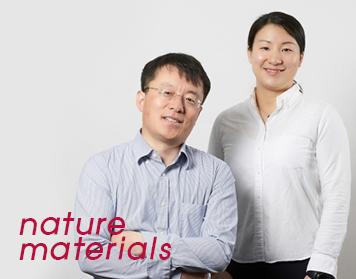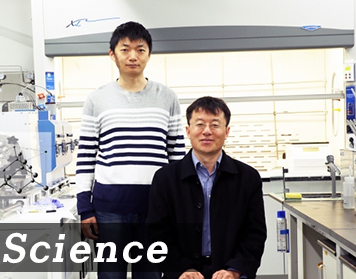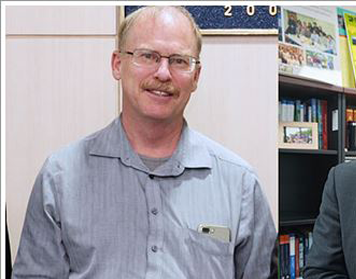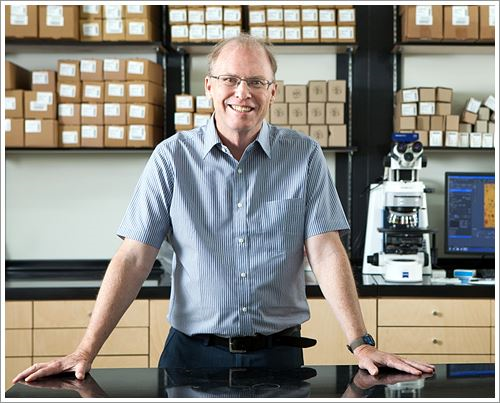UPDATES
IBS Center for Multidimensional Carbon Materials
Total : 61, Now : 8 page

An international team of researchers, affiliated with UNIST has discovered a novel method for the synthesis of ultrathin semiconductors. This is a unique growth mechanism, which yielded nanoscopic semiconductor ribbons that are only a few atoms thick.
This breakthrough has been jointly conducted by Distinguished Professor Feng Ding and Dr. Wen Zhao from the Center for Multidimensional Carbon Materials (CMCM), within the Institute for Basic Science (IBS) at UNIST, in collaboration with the National University of Singapore (NUS), the National Institute for Materials Science (NIMS), the National Institute of Advanced Industrial Science and Technology (AIST), and Shenzhen University.
In the study, the research team has successfully fabricated MoS2 nanoribbons via vapour-liquid-solid (VLS) growth mechanism, a type of chemical vapour deposition (CVD) process.
Dr. Wen Zhao from the IBS CMCM at UNIST. In the study, she performed density functional theory based molecular …
작성자 : CMCM
2018.10.11

Diamonds is the strongest naturally occurring material on Earth. It is also renowned for its incomparable properties, such as high stiffness, exceptional thermal conductivity, high chemical resistance, and high optical transparency. Although these remarkable properties of diamond make it highly desirable for many scientific and technological applications, progress has been slow due to its brittleness.
A recent study, affiliated with UNIST has unveiled that brittle diamonds can be bent and stretched elastically when made into ultrafine needles.
This breakthrough has been jointly conducted by Distinguished Professor Feng Ding’s team from the Center for Multidimensional Carbon Materials (CMCM), within the Institute for Basic Science (IBS) at UNIST, in collaboration with an international team of researchers from Massachusetts Institute of Technology (MIT), City University of Hong Kong, and Nanyang Technological University. The results of the study has been reported this week in th…
작성자 : CMCM
2018.10.11

Director Rodney S. RUOFF, CHANG Sukbok, HYEON TaeghwanRanked among Top 1% Highly Cited Researchers of The World in 2017
Director Rodney S. RUOFF, CHANG Sukbok, and HYEON Taeghwan of Institute for Basic Science (IBS) are listed in the top 1% of Highly Cited Researchers of The World in 2017 by Clarivate Analytics (formerly part of Thomson Reuters), a global academic information service firm.
▲ (From left) Director Rodney S. RUOFF of Center for Multidimensional Carbon Materials, Director CHANG Sukbok of Center for Catalytic Hydrocarbon Functionalizations, and Director HYEON Taeghwan of Center for Nanoparticle Research
Director Rodney S. RUOFF of Center for Multidimensional Carbon Materials was ranked in the categories of materials science, physics, and chemistry for three years in a row from 2015 after his name first appeared on the list in materials science and chemistry in 2014. Among the only 20 researchers whose names were mentioned in three categories t…
작성자 : CMCM
2018.10.11

Rodney S. (Rod) Ruoff, Distinguished Professor at the Ulsan National Institute of Science and Technology (UNIST) and Director of the Institute for Basic Science Center for Multidimensional Carbon Materials (IBS-CMCM), has been awarded the James C. McGroddy Prize for New Materials from the American Physical Society in recognition of his outstanding achievement in the science and application of new materials. Professor Ruoff has made and reported many scientific discoveries, and this prize was awarded “for pioneering contributions to the scalable synthesis, materials science and applications of graphene and graphene derivatives.” The prize will be awarded to Ruoff at the 2018 Spring Meeting of the American Physical Society to be held March 5-9, 2018 in Los Angeles, California, USA. Ruoff will also present an award lecture at this scientific meeting.Ruoff and his research team first published on graphene in 1999 in two peer-reviewed articles; one in the Journal of Applied Physics an…
작성자 : CMCM
2017.11.14

- IBS scientists develop a new platform to attach chemical groups on graphene lying on a silica/silicon substrate -
Researchers at the Center for Multidimensional Carbon Materials, within the Institute for Basic Science (IBS) at Ulsan National Institute of Science and Technology disclosed a new method to add chemical groups on (that is, to "functionalize") single layer (SLG) and bilayer (BLG) graphene lying on silica/silicon. This study, recently published online in the Journal of the American Chemical Society (JACS) also suggests how decorated graphene serves as a platform to produce 2D materials with new characteristics.
A single layer of carbon atoms packed in a honeycomb lattice, called graphene, is one of the most versatile materials ever made. Its excellent heat and electricity conductivity, combined with lightness and strength, offer compelling possibilities for a variety of useful functions.
To better tune the properties of graphene, the use of functionalized graphene, t…
작성자 : CMCM
2017.04.05

A key advancement in the design of high performance carbon-based electronics
Pioneering research published in Nature by Professor Feng Ding's team from the Center for Multidimensional Carbon Materials, within the Institute for Basic Science (IBS), in collaboration with Professor Jin Zhang's team, at Peking University and colleagues, has demonstrated how to control the synthesis of special tiny carbon cylinders known as carbon nanotubes (CNTs), in order to synthesize horizontal arrays of CNTs with the same structure.
▲ Structure of carbon nanotube (CNT). (Left) Illustration of rolling graphene into CNTs of different structures, denoted by two indices, like (8,4). (Right) Microscope images of an array of CNTs with the mean diameter of 1.21 nm. Due to their exceptional mechanical, electrical and thermal properties, CNTs are considered an excellent alternative to silicon for next generation microelectronics. However, since CNTs' electron…
작성자 : CMCM
2017.02.18
